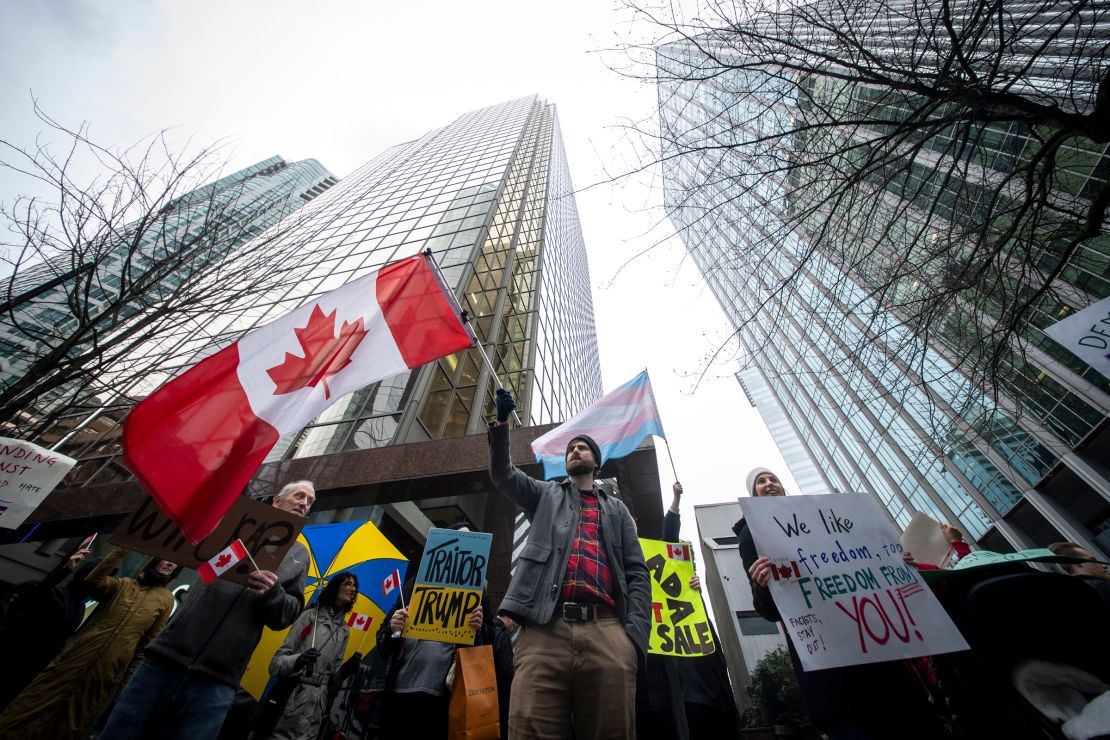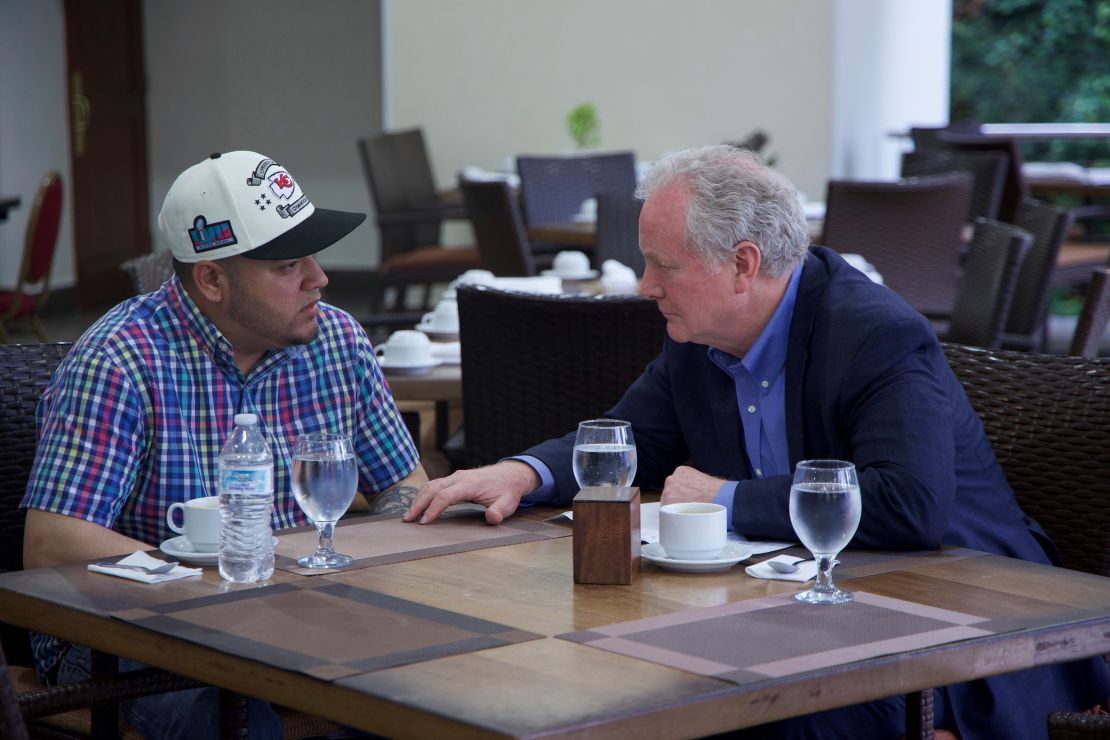Editor’s Note: President Donald Trump has repeatedly suggested the United States should acquire additional land by purchase, agreement, coercion – and he hasn’t ruled out using military force. Yet some promises for bold action are coming up short. This is Part 3 of an in-depth, contemporaneous look at the first 100 days of Trump’s second term.
CNN
—
“Shit, it’s cold here!”
Vice President JD Vance chooses the perfect introductory words for his brief visit to Greenland, if he were a tourist just in for some laughs and an Instagram moment. But as the highest-ranking official of the United States to ever set foot on the world’s largest island, Vance is there to talk about a much longer stay — to drive home President Donald Trump’s desire to control the snowy land.
“This has to happen,” Vance says. “And the reason it has to happen, I hate to say it, is because our friends in Denmark have not done their job in keeping this area safe.”
For months, the Danes have effectively said the only threat is from the United States. They’ve pointed out that Greenland, an autonomous land under the Danish umbrella, has happily hosted American military forces for decades. They note that Vance’s stop is at a US base established in 1943 and still operating. They argue the White House can easily keep an eye on Chinese and Russian movements in northern waters from the island and can even expand America’s military footprint there without owning the earth beneath it. Anyway, Denmark says, Greenland is not for sale. Locals give an icier answer to Trump, Vance and their representatives: “We don’t want you here.”
“We need Greenland,” Trump says as if he’s not heard a word. “For international security. We have to have Greenland.”

Since returning to power, Trump has revived talk of a concept born in the mid-1800s. Manifest Destiny is the idea that the United States is an exceptional nation created by God to rule all of North America — at the least. The concept was used to justify slavery, take land from Indigenous people and expand the country ever farther westward — starting several armed conflicts along the way. President Andrew Jackson, who ordered the brutal removal of many Native Americans from their ancestral homes, was a big fan, and Trump is a fan of his, hanging a portrait of Jackson in the Oval Office.
Trump is also casting his eyes beyond Greenland. Citing unproven claims of Chinese soldiers operating the Panama Canal, he said at his inauguration, “We didn’t give it to China. We gave it to Panama, and we’re taking it back.”
Although some Chinese companies have set up shop near the path between the seas, the Panamanian president called Trump’s claim “nonsense.” But a clause in the agreement that returned the canal to Panamanian control does permit the US to militarily “protect and defend” the vital waterway if America thinks it is being threatened. And Trump has unilaterally declared a threat does exist.
Trump also has grown covetous of war-torn Gaza, saying maybe the US should be given the deed. “We’ll own it,” he says. “We’re going to take over that piece, develop it and create thousands and thousands of jobs, and it will be something the entire Middle East can be proud of … the Riviera of the Middle East.” He even posts what looks to be an AI-generated, lurid video of what a luxury resort might look like, complete with a giant golden statue of himself.
His reliable defender, Republican Sen. Lindsey Graham of South Carolina, meets the scheme with a master class in understatement. “We’ll see what the Arab world says, but you know that’d be problematic at many, many levels.” Arab communities in the Middle East rapidly and broadly reject the proposal. Michigan Democratic Rep. Rashida Tlaib — the first Palestinian American woman to serve in Congress — calls Trump’s idea “fanatical bullshit.”
So that might be difficult. And then there is Canada.
“When I say they should be a state, I mean that. I really mean that,” Trump says. “It’s right next to us on our border. It would be a great state. It would be a cherished state.”
He’s griped endlessly about allegedly unfair Canadian trade practices (even though he negotiated and signed the current trade deal during his last term) and now he is pushing his solution: Let the US pick up the Great White North like a doughnut at Tim Hortons.
Canadians, despite their reputation as some of the most polite people on Earth, respond to the threats — and Trump’s threatened tariffs on the nation — by “dropping the gloves.” At hockey games they boo the American national anthem. Shops remove American products from their shelves, and “Buy Canadian” becomes a rallying cry from Newfoundland to the Yukon.

When the two countries’ national teams are set to drop the puck in the championship game of the 4 Nations Face-Off tournament, White House press secretary Karoline Leavitt quips, “We look forward to the United States beating our soon-to-be 51st state.”
The Canadians win in overtime, proving that adage of international relations: Never bet against a pass to Connor McDavid.
While each nation targeted by Trump has taken his words seriously, some of his aspirations are decidedly more perilous, as Ukrainian President Volodymyr Zelensky finds out in late February.
He’s been summoned to the White House to seal a deal giving the United States rights to rare earth minerals in his country. Zelensky has acknowledged continued American support for Ukraine is crucial to defending itself against Russia. Trump has said he is brokering a broader peace deal with Moscow.
“Oh, you’re all dressed up,” Trump says as Zelensky appears in black military attire, including a zip-up top emblazoned with Ukraine’s state symbol, a small trident representing the identity and self-determination of his country. The outfit is his trademark and a ready reminder to the world that his citizens are fighting and dying in a war they did not choose. But Trump is in his typical blue suit and red tie, and to some observers, his greeting drips with sarcasm.
Nonetheless, for 40 minutes their talk is cordial, with papers lined up for signing and lunch waiting. Then Vance jumps in to say Zelensky does not seem grateful enough for the diplomacy Trump is shepherding.
Zelensky looks befuddled. “What kind of diplomacy, JD, are you talking about?”
Vance fires back: “The kind that will end the destruction of your country.”
He accuses Zelensky of being disrespectful. The Ukrainian leader, who is interested in hearing how Washington might help deter Moscow’s aggression, essentially says Russian President Vladimir Putin can’t be trusted to abide by any agreement without muscle.
Trump, who has openly fawned over Putin and famously sided with him over American intelligence officers, has had enough.
“You’re, right now, not really in a very good position,” he warns Zelensky. “You don’t have the cards right now.”
“I’m not playing cards,” Zelensky says.

Shouting starts. Trump calls former President Joe Biden “stupid” for giving the Ukrainians so much money for the fight, and he invokes the idea of a World War III. Zelensky is battered on all sides. He and his party leave.
Perhaps Zelensky should have seen it coming.
Before the meeting, Trump had falsely called the Ukrainian leader a “dictator” while refusing to pin the same tag on Putin. The American president had accused Ukraine of starting the war, although Russian forces indisputably rolled tanks and opened fire across the border in its latest invasion three years ago. Trump had started peace talks with Russia without inviting Zelensky, and he had signaled that Ukraine would almost certainly have to give up some, if not all, the land Russia had occupied.
And Trump had bristled when Zelensky said prior to their explosive meeting that the American president was “surrounded by misinformation” — a comment close political observers suspected Trump took as an insult.
Democratic Sen. Jack Reed of Rhode Island watches the diplomatic meltdown and concludes Zelensky walked into “a political ambush and a shameful failure of American leadership.”
Trump briefly withholds partial American intelligence from the Ukrainian forces. Zelensky expresses regret over the tone of the meeting. The peace talks, such as they are, continue. But despite Trump’s frequent campaign promises that he could and would end the war on “Day 1” of his new term, months are passing.
The fighting goes on.
Another battle Trump is waging with limited effect was also tied to a “Day 1” pledge.
“I will declare a national emergency at our southern border,” he said in his inaugural address. “All illegal entry will immediately be halted, and we will begin the process of returning millions and millions of criminal aliens back to the places from which they came.”
The boast was taken so seriously, human rights activists warned of vast detention camps springing up near the border where people would be herded and held until they were whisked out of the country.
“It’ll begin very early, very quickly,” Trump told NBC News.
Soon camera crews were following armed squads of agents fanning out to find, seize and deport masses of targeted individuals. But ride-along videos did not reveal thousands of dramatic arrests so much as hours of tedious, costly searching that sometimes netted a single person, a few or none.
There were some photo ops of people being hustled onto planes and sent away, but a month into the effort, White House border czar Tom Homan was asked about the pace by CNN’s Dana Bash.

“You’ve said roughly 14,000 migrants have been arrested … and that’s well below the 1,500 daily arrests the president has said he wants to see,” she said.
“I’m not happy with the numbers,” Homan admits, “because we’ve got a lot of criminals to find, so what we’re talking about right now is increasing the number of teams … and I’ll be honest with you, sanctuary cities are causing us a lot of work. … It’s hard work, but we’re not giving up.”
Generally, as the weeks progress, the pace of deportations has held steady compared to last year under Biden. There are plenty of reasons beyond the difficulty of finding people who don’t want to be found. Nations must agree to accept the deportees, transportation must be arranged, and despite the president dispatching military troops to help protect the southern border, some people are still coming in as others are sent out.
And of course, legal challenges to the deportations must be heard. Or maybe not.
El Salvador’s Center for Terrorism Confinement, or CECOT, is a sprawling complex of towers, guards, steel bars and razor ribbon at the base of a volcano. Under tight security, inmates are handcuffed and frog-marched in white shorts from place to place, and some can wind up in solitary cells devoid of light save what filters through a small hole in the ceiling. With a capacity of 40,000, the prison was opened in 2023 as an answer to an explosion in extreme gang violence in El Salvador.
CNN’s David Culver visits and says the facility “isn’t just a prison, it’s a message from this government to the gangs and really to the rest of the world.”
For the Trump White House, it is also a solution.
In mid-March, the administration loads hundreds of people collected in immigration sweeps onto planes and sends them south, alleging they are tied to dangerous criminal activity. The US is paying the government of El Salvador $6 million to take them, and even though a tense battle breaks out with a federal judge over the flights, the deportees wind up incarcerated at CECOT — among them, a Maryland man named Kilmar Armando Abrego Garcia.
And suddenly Team Trump has a new problem.
A working man with a wife and children, Abrego Garcia is 29 and his attorney says he has no criminal record or ties to gangs. Indeed, his attorneys say he fled El Salvador as a teenager under threat from the very dangerous groups for which CECOT was built. When US immigration officials found him living on the East Coast without documentation in 2019, a judge took the danger to his life seriously enough to say he could be deported but not back to El Salvador.

Confronted with the evidence, administration officials tell the court: “The United States concedes that removal (of Abrego Garcia) to El Salvador was an administrative error.” The court says the White House must bring him back. The Supreme Court says a version of the same. Then things get really messy.
“First and foremost, he was illegally in our country.” US Attorney General Pam Bondi echoes White House claims that this is the business of the executive branch, not the courts; that the Justice Department believes Abrego Garcia really is a gang member, though they have offered no public proof; that El Salvador has him now — and that the White House has no right to tell a foreign government what to do.
When President Nayib Bukele of El Salvador visits Trump in the Oval Office, the argument becomes a feedback loop of resistance. Asked by CNN’s Kaitlan Collins whether he will return the Maryland man, Bukele smiles and says, “How can I smuggle a terrorist into the United States? Of course, I’m not going to do it.”
Trump not only expresses admiration for the hard line of the Central American leader, he also says he’d like to send more people – maybe even Americans accused of violent crimes – to CECOT.
“I don’t know what the laws are; we always have to obey the laws,” Trump says, “but we also have homegrown criminals … that are absolute monsters. I’d like to include them in the group of people to get them out of the country.”
Amid growing evidence the Trump administration is doing little to comply with certain court orders, former US Attorney Harry Litman sums up the episode in a sentence: “It is way, way beyond the pale and just contempt for the Constitution and the rule of law.”
New York Times reporter Adam Liptak, who covers the Supreme Court, says on “The Daily” podcast that as a legal matter, the same argument the White House used against Abrego Garcia’s return could be used against anyone, including US citizens. He says the White House is essentially saying, we arrested this person and sent him to a foreign prison without due process because we were in a presidentially declared emergency. We made a mistake. But now we can’t bring him back. “The logic and implications of the administration’s position can only be called deeply disturbing,” Liptak says.
When a judge argues there is reasonable evidence to hold White House officials in criminal contempt for stonewalling the court’s orders in regard to some of the deportation flights – including the one with Abrego Garcia aboard – some political watchers fear Trump’s actions are pushing the nation ever closer to a constitutional crisis. Yet the White House seems to be declaring itself unanswerable to the courts or Congress, but a supreme power — not to be challenged, questioned or stopped by anyone.
CNN’s Kaanita Iyer contributed to this report.
